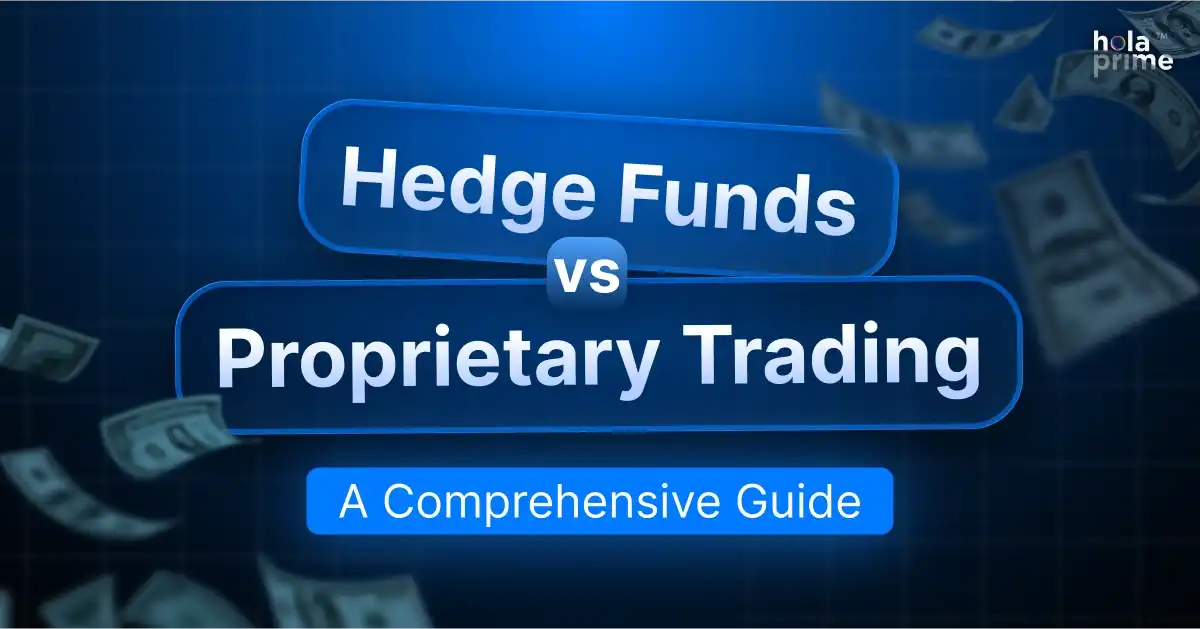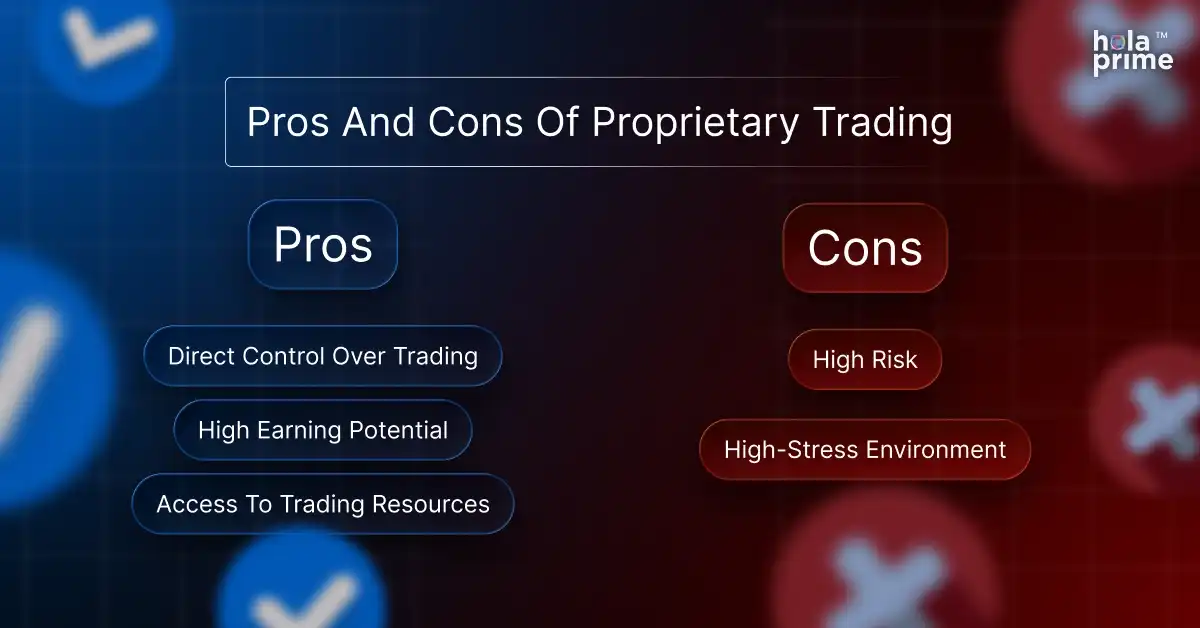Hedge Funds vs Proprietary Trading: A Comprehensive Guide
- Ankit Gupta
- February 5, 2025

The financial world includes many types of firms, each with its own way of working. Hedge funds and prop trading firms both trade in the markets, but they do it in different ways, with different goals and levels of risk.
Knowing how they differ helps investors, traders, and others make smarter choices—whether they’re looking to invest, join a firm, or build a career in trading.
We’ve got you covered. Read on to find out the key differences between prop trading and hedge funds.
The financial world includes many types of firms, each with its own way of working. Hedge funds and prop trading firms both trade in the markets, but they do it in different ways, with different goals and levels of risk. Knowing how they differ helps investors, traders, and others make smarter choices—whether they’re looking to invest, join a firm, or build a career in trading.
Key Takeaways
- Hedge funds manage money on behalf of clients (usually wealthy individuals or institutions)
- Proprietary trading firms provide their capital to traders and split profits with traders
- Prop trading greater autonomy and lower barriers to entry
- Hedge funds are highly regulated and come with high fees and investment minimums
- Both offer high earning potential but differ significantly in structure and strategy
What Are Hedge Funds?
Hedge funds are pooled investment funds that use a range of strategies to generate high returns for investors. They are typically open only to accredited or institutional investors due to their complex nature and risk level.
The term “hedge funds” is crafted of two words:
- Hedge – means “protection”
- Funds – means “money”
Therefore, hedge funds are entities or private pools of money that ensure the protection of your funds even in situations of market downturn.
How Do Hedge Funds Work?
Hedge funds work by pooling money from investors and using it to invest in different markets using distinct strategies to earn profits. The main motive of hedge funds is to generate more money in comparison to the invested money in the market.
Hedge fund managers make decisions based on market trends, data, and analysis. Profits made from successful investments are shared among investors, while the hedge funds earn money via performance fees and management fees.
Who Are the Key Players in Hedge Funds?
- Fund Managers – They are the ones who manage and plan where to invest the money of their investors. You can consider them like the “captains” of the ship.
- Analysts – They are the individuals who research and analyze investments and help fund managers to make good decisions. They’re like the “detectives”.
- Investors – The ones who put their money in the hedge funds to gain some profits. Investors are mostly elite-class rich people or business tycoons who invest in hedge funds.
How Do Hedge Funds Make Money?
Hedge funds primarily make money by using two ways:
- Performance Fees – When hedge funds make a profit, they take a cut of those profits as a performance fee. This fee is usually the percentage of the profits that the fund makes for its investors. Generally, it’s 20% of the profits that funds cut as performance fees.
- Management Fees – The fee that is charged for managing the money of the investors is known as the management fee. Hedge funds usually cut 2% of the total amount of money that investors have in the hedge fund. Management fees are like paying hedge funds as a service fee for managing investors’ money.
Pros and Cons of Hedge Funds
The advantages and disadvantages of hedge funds are:
Pros:
- Diversified Strategies Reduce Risk – Hedge funds are known for using various investment strategies, like buying and selling undervalued and overvalued stocks or investing in distinct financial instruments and assets in the market. Therefore, the diversification of strategies helps spread risk and can potentially lead to more stable and higher returns.
- Managed by Experienced Professionals – Hedge funds are managed by experienced and knowledgeable professionals who always try to make informed decisions and aim to maximize profits for investors.
- Potential for High Returns – Hedge funds are considered the best investment approach because it has the potential to gain very high returns as compared to other investments, especially when market conditions are favorable.
Cons:
- High Fees – Hedge funds typically charge higher fees, including a management fee (a percentage of the total investment) and a performance fee (a percentage of the profits made). These high fees can eat up all your returns.
- Minimum Liquidity – Hedge funds often have restrictions on when you can withdraw your money. Investors have to complete their lock-in period and then the notice period to get their money out. The time of these specific periods can vary depending on distinct hedge funds.
- Large Minimum Investment Requirements – Investing in hedge funds requires a lot of money, which makes them accessible to only the elite class and wealthy individuals or institutions. Therefore, a high investment shows that they are not an option for everyone.
Example of a Hedge Fund
Let’s take Bridgewater Associates as an example – one of the largest and most well-known hedge funds in the world. Founded by Ray Dalio, it manages billions on behalf of institutions like pension funds and governments, using a strategy called macro investing.
This means the fund makes decisions based on global economic trends (such as interest rates, inflation, or political shifts), aiming to profit in both rising and falling markets.
As an investor, hedge funds like Bridgewater Associates give you access to professionals who manage your money using research-driven strategies. They have high entry requirements, however, and may only be available to you if you’re an accredited or institutional investor.
What Is Proprietary Trading?
Proprietary trading (or “prop trading”) is when a firm provides its own money to traders to trade financial instruments like forex, crypto or commodities. The goal is to generate profits for the firm, rather than earning commissions from client trades.
➤ Learn more about prop trading firms.
The term “proprietary trading” is made up of two words:
- Proprietary – means “something that is owned or operated by a particular company”
- Trading – means “the buying and selling of trading instruments like forex pairs, commodities, indices, cryptocurrencies, etc. to make some profit.”
Therefore, the buying and selling of trading instruments by using firms’ own money to gain profit is known as prop trading.
How Does Proprietary Trading Work?
Prop firms provide their capital to traders, who must first pass a qualification challenge. Profits are typically split between trader and firm, while losses are absorbed by the firm. Learn more about profit splits here.
Traders make decisions on which instrument to trade and share the profit earned with the prop firm. Proprietary trading is a high-risk and high-reward approach for prop firms as they take full responsibility for the losses.
Who Are the Key Players of Proprietary Trading?
- Traders – These are the individuals who actively engage in the buying and selling of financial instruments such as commodities, indices, currencies, and others using the prop firm’s money.
- Risk Managers – These are those people who monitor and control the amount of risks the traders are taking in the market. Risk managers ensure that traders are within safe limits to prevent big losses for the prop trading firms.
- Proprietary Firms – These are the firms or companies that are equipped in prop trading. They provide trading capital and resources to traders.
How Do Proprietary Trading Firms Make Money?
Let’s explore the top three ways mostly used by prop trading firms to earn profits in the market.
- Trading Profits – The prop traders trade with firms’ capital and share a portion of the profit earned with the prop firm.
- Challenge Fees – To access a prop firm’s capital, traders have to pass a set of prop challenges (generally known as evaluation criteria). There is usually a lesser or certain amount of fee that traders have to pay to appear for a challenge.
- Platform Fees & Subscriptions – Some firms offer analytics tools or training resources for a fee.
Pros and Cons of Proprietary Trading
The advantages and disadvantages of proprietary trading are:

Pros:
Direct Control Over Trading – Prop trading firms, companies, or institutions allow their traders to have full control to make informed decisions based on their market analysis. This is the key feature that allows them for quick adjustments to trading strategies in the market.
High Earning Potential – Prop trading has a high earning or huge profit-making potential in the market. Successful prop traders can earn substantial profits because they share gains made by them with the firms.
Access to Trading Resources – Prop trading firms provide access to trading and educational resources, which helps traders pass a prop trading challenge with ease. Therefore, aspiring traders can access educational resources like YouTube videos, trading lessons, and live sessions to get access to prop firm capital effortlessly.
Cons:
High Risk – Prop trading involves significant risk as the capital of the prop trading firm is at stake. It’s always advisable for traders to manage risks carefully to avoid substantial losses because it might impact the financial health of the prop trading firm.
High-Stress Environment – Prop trading has a highly stressful environment as to perform well and gain profits, traders have to constantly monitor the market’s movements and make quick decisions in the market. You must learn to avoid emotional trading to increase the chance of success.
Comparing Hedge Funds and Proprietary Trading
Now, let’s check the comparison between the hedge funds and proprietary trading:
Aspect | Hedge Funds | Proprietary Trading |
Purpose | Manage money for clients to earn profits | Provides funds and resources to traders who trade to earn a profit |
Capital Source | Money from external investors | Firm’s own capital |
Clients | Wealthy individuals, institutions | Traders who pass the evaluation |
Risk Bearing | Risks are shared between investors and the fund | Firm bears all the risks |
Fee Structure | Management and performance fees | Challenge fees |
Regulation | Subject to more regulations | Subject to fewer or no regulations |
Investment Strategies | Variety of strategies (long/short, event-driven, etc.) | Traders trade as per their own trading strategies |
Holding Period | Can hold positions for longer periods | Depends on the trader-to-trader and the firm’s rules |
Transparency | Must provide performance reports to investors | No obligation to disclose performance publicly |
Goal | Generate returns for clients while managing risk | Maximize profits for the firm |
Note: Hola Prime offers a Daily Price Transparency Report to ensure fairness, reliability, and accountability among its prop traders.
What Are The Key Differences Between Hedge Funds and Prop Trading?
Here are the core differences between hedge funds and prop trading, from the source of capital to risk and regulation:
Capital
- Hedge Funds – Use capital from external investors, such as high-net-worth individuals, pension funds, and institutions. Fund managers are responsible for growing this capital while preserving the investors’ trust.
- Prop Trading Firms – Trade with their own capital. Traders are given access to the firm’s money after passing an evaluation. No outside investors are involved.
Client
- Hedge Funds – Serve clients (usually wealthy investors) who entrust the fund with their capital in exchange for potentially high returns.
- Prop Trading Firms – Work with traders who are tested and then get simulated funding to trade the firm’s capital. Profits are performance-based, with no long-term commitment to the firm.
Risk
- Hedge Funds – Risk is shared between the fund and its investors. Strategies are diversified to manage this risk across assets. Losses affect the clients’ invested capital, not the firm’s internal funds.
- Prop Trading Firms – The firm bears all financial risk. If the trader loses money, it’s the firm’s capital at stake. However, traders must adhere strictly to risk limits or lose access to funding.
Regulation
- Hedge Funds – Subject to stringent regulations, especially in the U.S, EU and UK. These may include disclosures, compliance checks, audits, and licensing under financial regulators like the FCA or SEC.
- Prop Trading Firms – Less regulated because they do not handle client funds. However, this is changing across many countries.
Strategy
- Hedge Funds – Use complicated, multi-asset strategies (such as long/short equity, macro, event-driven, arbitrage) and often take longer-term positions. The goal is to outperform benchmarks while managing risk.
- Prop Trading Firms – Traders choose their own strategies (scalping, swing trading, intraday, etc.) depending on the firm’s rules. The focus is on short to medium-term trades with clear performance targets.
Gains
- Hedge Funds – Investors typically earn returns based on the fund’s overall performance, often after fees like the “2 and 20” model (2% management fee + 20% of profits). These gains are distributed to investors and aren’t guaranteed.
- Prop Trading Firms – Traders earn a share of the profits they personally generate using the firm’s capital. This is usually structured as a profit split (for example, 80/20 or 90/10), with the trader keeping the larger share.
What Are The Similarities Between Hedge Funds and Prop Trading?
- Both aim to profit from market movements.
- Both can use leverage and sophisticated strategies.
- Both involve high risk and reward potential.
- Both attract skilled traders with strong market knowledge.
Ready To Start Prop Trading?
We’ve explored the key differences between hedge funds and proprietary trading with a detailed explanation of the pros and cons of both approaches.
To summarise: Hedge funds manage capital by using various strategies, whereas proprietary trading involves firms providing their capital to traders to gain profits in the market.
Explore Hola Prime’s platforms and account types to begin your journey:
Trade with confidence with Hola Prime. We give you the tools, support and funding to execute trades successfully.
FAQs
1. How do I choose between hedge funds and prop trading?
When choosing between hedge funds and proprietary trading, consider your personal goals and risk tolerance. Hedge funds offer professional management but require a lot of money to invest with less control over your funds. Proprietary trading provides direct control with high potential returns and access to a large pool of funds but also carries higher risks and pressure.
The decision to choose between hedge funds and proprietary trading should align with your investment goals and financial objectives.
2. Do prop traders get a salary?
Not usually. Some prop trading firms offer a base salary, but most operate on a profit-sharing basis. Traders only earn after proving profitability and passing an evaluation.
3. Can you lose money in a prop firm?
No – you won’t lose your own personal funds. However, if you breach risk rules or consistently lose, you may lose access to firm capital.
4. Are hedge funds safer than prop trading?
Hedge funds are regulated and have diversified strategies, which can reduce risk. However, they’re still high-risk investments and not suitable for everyone.
5. How do I choose the right prop firm for me?
Choosing the right prop firm depends on your trading goals, experience level, and the type of markets you want to trade. Start by looking at the funding model. Some firms offer instant funding, while others require you to pass a challenge first. Consider the profit split, drawdown rules, and whether they offer support like coaching, tools, or a community.
Disclaimer: All information provided on this site is for educational purposes only, related to trading in financial markets. It is not intended as financial advice, business or investment recommendation, or as an opportunity or recommendation to trade any investment instruments. Hola Prime only provides an educational environment to traders, including tools, materials and simulated trading platforms which have data feed provided by Liquidity Providers. The information on this site is not directed at residents in any country or jurisdiction where such distribution or use would be contrary to local laws or regulations.

